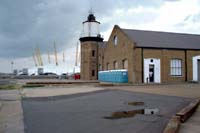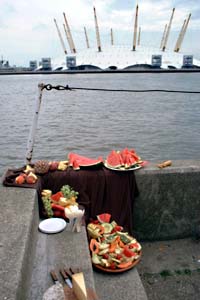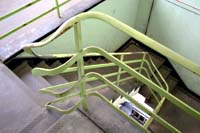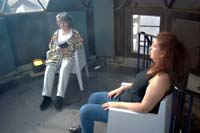Epson’s Advanced Black and White (ABW) printing system on Permajet Fibre Base Gloss (PFBG)
With any printing system using a computer the aim is to make good prints that correspond to the image that you see on screen. I made my prints using Photoshop, which displays images making use of a print space. Since I was printing black and white images I chose to use a grayscale print space, and for simplicity I chose my default grayscale working space, Gamma 2.2 – although other working spaces should give identical results if applied both to screen and in printing.
I started by reading the very useful work on simple black and white printing by Clayton Jones and then decided to try an even more straightforward approach! Here, in a more or less logical order are my notes on how I did it.

Notting Hill Carnival, 1996
Monitor set up
The monitor was calibrated to the usual D65 (6500K) and Gamma 2.2 that I use to get accurate colour.
Files
I scanned the negatives at the highest optical resolution my films scanner will give (4800 dpi for 35mm negs.) I use Vuescan as the scanner driver, preferring the results from this to those from either the Minolta software or Silverfast, particularly for negatives on chromogenic films (scanned as colour negative) but it also does a good job on black and white. I use a light amount of Infrared cleaning on chromogenic negatives and no grain reduction. Most automatic cleaning processes increase scan time and destroy detail. The scan at 4800 dpi allows for excellent prints up to around 24×16″ and so long as the negatives (and scans) are sharp you can go larger, with cost being the main limit!
Of course the quality of your prints will depend critically on good scans, and if you have any doubt about this, it may pay you to have scans made commercially on a drum scanner. Using a Minolta Dimage Scan MultiPro with a Scanhancer diffuser and setting Vuescan to sample the image four times gives similar quality to drum scans – just a pity that scanner is no longer available.
Files are saved as 16 bit grayscale tiffs and with gamma 2.2 – my Adobe Photoshop grayscale working space. You can print from 16 bit tiffs and it is bet8-818-6er to keep this format in case you want to work further on the images.
Photoshop
The first task is to spot the image, working at 100% view. get the image looking exactly how I want it on the monitor, spotting, adjusting contrast and levels, dodging and burning (I find it easier to work most of the time using rough selections with considerable feathering and then to apply either levels or curves rather than either the dodge/burn tools or working with layers and masking etc – it just seems more like I used to do it in the darkroom.) I then save the file, and apply a small amount of mainly edge sharpening with the Focal Blade plugin ready for printing.
Print Settings
It turned out easier than I expected to get the print to be a more or less exact match to the on-screen image, using the following printer settings:
In the print preview window, selecting colour management, select the Document: Gray Gamma 2.2 as the source space, and the print space to “Same as Source“. See below for some comments on the maximum size and margins required. Click on the print button and then make the printer settings.
To print on glossy papers such as PFBG, you need to use the glossy photo black (PB) ink cartridge instead of the matt black used for matt papers. With this loaded you should be able to select Epson Premium Glossy as the paper type. Then chose ‘Best Photo‘ for print quality. Check the paper feed (Sheet), paper size settings and orientation are correct. Empty all five boxes under ‘Print Options’ and select ABW.
In the ABW settings, choose ‘Fine Adjustment‘ and ‘Normal‘ and adjust the Horizontal and Vertical settings to give the ink colour you prefer – I found 3v and 3h gave a very slightly warm neutral which I liked. Leave all other settings at 0 or empty and ‘OK’ the dialogue.
In the paper configuration dialogue I found a Color Density of around +2 gave a slightly better match between screen and print. Finally, on the maintenance tab of the printer properties, checking the ‘thick paper’ box will cut down the paper handling problems (see below) slightly, though you will have to confirm this when you print.
Paper Handling
The main problems I had in making prints on PFBG were in loading the paper and in avoiding catastrophic collisions between paper edge and print head. PFBG – at least after some months of storage in my dampish house – is never flat, but curls up considerably along the long edges. Possibly this could be corrected by leaving it under heavy objects for a day or two, but a quicker method is to place a pile of several sheets face down on a clean sheet of cheaper paper, then roll the whole pile up from each short end in turn. It’s also worth doing a little rolling against the curl along each long side of the heap.
At first I had great problems in getting the paper to load at all, even after this flattening, although some other papers were loading without problems. The solution was to clean the roller that pulls it into the printer. I borrowed a glass drying cloth from the kitchen, folded it a few times and dampened it, then held the moist (but not dripping!) pad reasonably firmly against the rubber roller while pressing the paper feed button to make it attempt 3 or 4 print load cycles.
After this, I fed a sheet of cheap paper through the printer a few times to remove any moisture or dirt – always a good idea before feeding in your paper that costs a couple of pounds for an A3 sheet.
I soon also found that it was not possible to reliably use the whole print area of the A3 sheet. Even with the paper flattened as described above, there was still the occasional slight clip of the paper edge by the print head, which wasn’t a great problem while the sheet was held by the rollers, but knocked it askew once the end had emerged from these. So although A3 paper is 420 mm long, the longest print you can make is around 380mm, with a left margin (assuming a landscape format print) of around 2mm and a right margin approaching 40mm. It annoys me to print off-centre like this, but it’s even more annoying when the print-head catches the paper edge and messes up the print.
While the print is emerging from the printer (its appearance on the paper, gradually building up through multiple passes of the print-head has much of the same magic as the image appearing in the developer tray) it also can help avoid clipping to hold the edges of the paper down slightly as it leaves the front of the printer. But even so, most of the prints I made have slightly messy edges.
You can see the results of my printing session on show in English Carnival at the Shoreditch Gallery at The Juggler, 5 Hoxton Market, London, N1 6HG from 29 Sept- 31 Oct 2008 (Mon-Fri 8am-6pm, Sat 10-4pm, closed Sundays. ) You are welcome to the opening on Thursday 2 Oct, 6.30-8.30pm. This is one of over a hundred exhibitions and events in London as a part of photomonth 08 (this years web site with full details should be on line shortly) making this the largest photography festival in the UK.
For a more general look at my attempts at getting fine prints from a desktop inkjet printer, see Making Fine Inkjet Prints



















